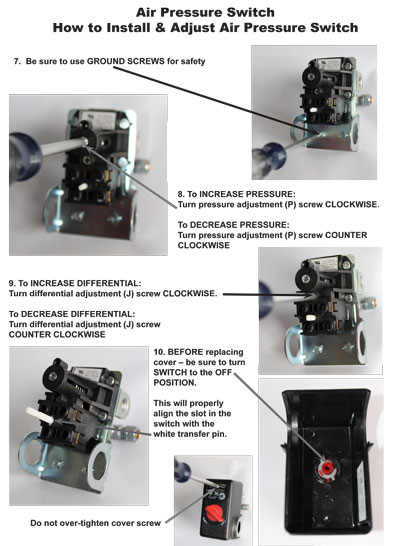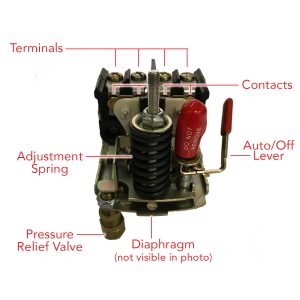To adjust an air compressor regulator, turn the adjustment knob until the desired pressure is reached. Check the gauge to confirm.
Adjusting the air pressure of your air compressor is crucial for optimal performance and tool longevity. Properly set air pressure ensures efficient operation and prevents damage to both the compressor and connected tools. Understanding the steps to adjust the regulator can save time and improve safety.
This guide will provide clear instructions for precise adjustments, helping you maintain the ideal pressure settings for various tasks. Whether you’re a DIY enthusiast or a professional, mastering this skill can enhance your workflow and extend the lifespan of your equipment.
Tools Needed
To adjust your air compressor regulator, you’ll need specific tools. Having the right tools ensures safety and efficiency. Here’s a guide to the tools needed for this task.
Basic Tools
- Wrench Set: Wrenches help you loosen or tighten nuts and bolts.
- Screwdriver Set: Screwdrivers are essential for adjusting screws.
- Pressure Gauge: This tool measures the air pressure accurately.
- Plumber’s Tape: Use this tape to seal threaded joints.
Safety Gear
- Safety Glasses: Protect your eyes from debris.
- Work Gloves: Gloves protect your hands from injuries.
- Ear Protection: Air compressors can be noisy; protect your ears.

Preparing The Compressor
Before adjusting your air compressor’s regulator, you must prepare the compressor. Proper preparation ensures safety and efficiency. Follow these steps to get your compressor ready for adjustment.
Powering Down
Begin by turning off the air compressor. Unplug the machine from the power source. This step prevents accidental startups. Ensure the compressor is completely powered down.
Draining The Tank
Next, drain the air tank. This removes any moisture and built-up pressure. Locate the drain valve at the bottom of the tank. Open the valve to release the air and moisture.
Use a bucket to catch any water. Close the valve once the tank is empty. Draining the tank protects the compressor from damage. It also ensures accurate pressure adjustments.
Locating The Regulator
To adjust air compressor air pressure, you first need to locate the regulator. This component controls the pressure output from your air compressor. Without locating it, adjusting the pressure becomes impossible.
Understanding The Components
An air compressor consists of several crucial parts. These include the tank, motor, pressure switch, and regulator. Each component plays a specific role. The tank stores compressed air. The motor powers the compressor. The pressure switch regulates when the motor turns on and off. The regulator adjusts the air pressure output.
Understanding these components is vital for effective air compressor usage. Knowing where each part is located simplifies the adjustment process.
Identifying The Regulator
The regulator is usually a knob or dial. It is often located near the pressure gauge. The gauge shows the current air pressure in the tank. The regulator adjusts this pressure to your desired level.
To identify the regulator, look for a knob or dial marked with pressure levels. It is generally positioned next to the pressure gauge. Some models may have it on the side or front panel. Once you find it, you can begin the adjustment process.
| Component | Function |
|---|---|
| Tank | Stores compressed air |
| Motor | Powers the compressor |
| Pressure Switch | Regulates motor activity |
| Regulator | Adjusts air pressure output |
- The tank stores air.
- The motor powers the unit.
- The pressure switch controls motor activity.
- The regulator adjusts air pressure.
- Find the pressure gauge.
- Look for the nearby knob.
- Identify markings on the knob.
- Confirm it’s the regulator.
Locating the regulator is the first step in adjusting air pressure. Without finding it, you cannot proceed. Always refer to the user manual for specific model details.

Adjusting The Regulator
Adjusting the air compressor regulator is crucial for optimal performance. The regulator controls the air pressure output. This ensures your tools receive the right amount of air pressure. Follow these steps to adjust the regulator accurately.
Turning The Knob
Locate the regulator knob on your air compressor. It is usually near the pressure gauge. Turn the knob clockwise to increase pressure. Turn it counterclockwise to decrease pressure.
Make small adjustments to the knob. Check the pressure gauge frequently. This helps you avoid over-adjusting.
| Direction | Action |
|---|---|
| Clockwise | Increase Pressure |
| Counterclockwise | Decrease Pressure |
Setting Desired Pressure
Determine the required pressure for your tool. This information is in the tool’s manual. Set the regulator to this pressure.
- Turn the compressor on.
- Turn the regulator knob to adjust the pressure.
- Check the gauge for the desired pressure.
Once set, test the tool briefly. Make sure it operates correctly. If not, adjust the pressure again. Repeat until the tool works perfectly.
Always monitor the pressure gauge. It helps in maintaining consistent pressure. This ensures the longevity of your tools and the compressor.
Testing The Pressure
Testing the pressure of an air compressor is crucial. It ensures your compressor works efficiently. This process helps in maintaining the correct air pressure. Follow the steps below to test the pressure accurately.
Using A Pressure Gauge
A pressure gauge is an essential tool. It measures the air pressure in the compressor. Start by connecting the gauge to the air compressor. Ensure the connection is tight and secure.
Turn on the air compressor. Watch the needle on the pressure gauge. It will move to show the current pressure. Compare the reading with the required pressure for your task. Adjust the regulator if needed to match the desired pressure.
Ensuring Consistency
Consistency is key for optimal performance. Check the pressure gauge regularly during use. This ensures the pressure remains stable. Fluctuating pressure can harm your tools and affect work quality.
Make small adjustments to the regulator as needed. Always monitor the pressure gauge to maintain the set pressure. Consistent pressure helps in achieving precise results.

Securing The Settings
After adjusting the air compressor, securing the settings is crucial. This ensures stable performance and safety. Below are the steps to secure your air compressor settings effectively.
Locking The Knob
Once you have set the desired pressure, lock the knob. This prevents accidental changes. Most air compressors have a locking mechanism. Follow these steps:
- Turn the knob to the desired pressure setting.
- Press or pull the knob to engage the lock.
- Check if the knob is firmly locked in place.
Locking the knob is vital. It ensures consistent air pressure during operation. Refer to your compressor’s manual for specific locking instructions.
Double-checking Adjustments
Double-checking your adjustments guarantees accuracy. Follow these steps to confirm your settings:
- Inspect the pressure gauge to verify the set pressure.
- Listen for any air leaks around the regulator.
- Test the air tool or equipment connected to the compressor.
Double-checking adjustments helps avoid potential issues. It ensures your air compressor operates safely and efficiently.
| Step | Action |
|---|---|
| 1 | Set the desired pressure |
| 2 | Lock the knob |
| 3 | Verify the settings |
Follow these steps to secure your air compressor settings. This ensures optimal performance and safety.
Maintenance tips
Proper maintenance of your air compressor ensures longevity and optimal performance. Follow these essential tips to keep your air compressor in top shape.
Regular Inspections
Regular inspections are crucial for any air compressor. Check for leaks, wear, and tear. Inspect hoses and connections for any signs of damage. Ensure the regulator is functioning properly.
- Visual checks: Examine the exterior for any visible issues.
- Connection checks: Ensure all hoses and fittings are tight.
- Leak detection: Listen for hissing sounds indicating leaks.
Troubleshooting Issues
Troubleshooting issues promptly can save you from costly repairs. Identify problems early and address them immediately.
| Problem | Solution |
|---|---|
| Low pressure | Check for leaks and tighten connections. |
| Regulator not adjusting | Ensure the regulator knob is not damaged. |
| Overheating | Clean filters and ensure proper ventilation. |
Keep a maintenance log to track issues and repairs. This helps in diagnosing recurring problems.
Follow these simple steps to maintain your air compressor and ensure its longevity. Regular inspections and troubleshooting will keep your equipment running smoothly.
Frequently Asked Questions
How Do You Adjust An Air Compressor Regulator?
To adjust an air compressor regulator, locate the regulator knob. Turn it clockwise to increase pressure or counterclockwise to decrease it. Check the pressure gauge to ensure the desired PSI is reached.
Why Is Air Compressor Pressure Adjustment Important?
Adjusting air compressor pressure is crucial for tool efficiency and safety. Proper pressure ensures optimal tool performance and prevents damage. Always set the pressure according to tool specifications.
Can Adjusting Air Pressure Damage Tools?
Yes, incorrect air pressure can damage tools. Too high pressure can cause malfunctions or breakage. Too low pressure reduces efficiency. Always follow manufacturer guidelines for optimal performance.
How Often Should You Check Air Compressor Pressure?
Check air compressor pressure before each use. Regular checks ensure safety and optimal performance. Frequent monitoring prevents potential damage to tools and the compressor.
Conclusion
Mastering air compressor regulator adjustments ensures optimal performance and longevity. Follow these steps for accurate pressure control. Regular checks and proper maintenance are essential. Adjusting air pressure correctly can improve efficiency and extend your compressor’s life. Keep these tips in mind to maintain your equipment in top condition.

